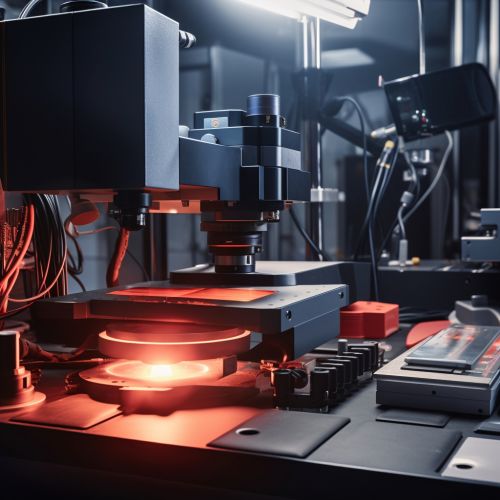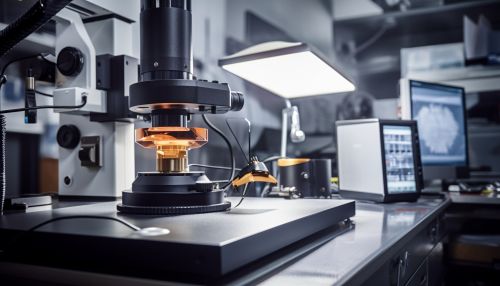Nanolithography
Introduction
Nanolithography is a branch of nanotechnology dealing with the study and application of fabricating nanometer-scale structures, meaning patterns with at least one lateral dimension between the size of an individual atom and approximately 100 nm. The term is derived from the Greek words nanos (dwarf), lithos (stone) and graphein (to write). It is used in the field of microfabrication where it is used for patterning parts of a thin film or the bulk of a substrate.
History
The concept of nanolithography began with the development of the first scanning probe microscope in the 1980s. This was a significant milestone as it allowed scientists to visualize and manipulate individual atoms for the first time. The invention of the scanning probe microscope paved the way for the development of various nanolithography techniques.


Techniques
There are several techniques used in nanolithography, each with its own advantages and disadvantages. These include:
Photolithography
Photolithography is a process used in microfabrication to pattern parts of a thin film or the bulk of a substrate. It uses light to transfer a geometric pattern from a photomask to a light-sensitive chemical photoresist on the substrate.
Electron Beam Lithography
Electron beam lithography (EBL) is a method of etching semiconductors at a very fine scale, down to a few nanometers. It uses a focused beam of electrons to form custom shapes on a surface covered with an electron-sensitive film called a resist.
Nanoimprint Lithography
Nanoimprint lithography (NIL) is a method of fabricating nanometer scale patterns. It is a simple process with a straightforward stamping operation that can achieve resist patterns with a resolution of less than 10 nm.
Dip Pen Nanolithography
Dip Pen Nanolithography (DPN) is a scanning probe lithography technique where an atomic force microscope tip is used to "write" molecules onto a surface. This allows the creation of nanostructures from a wide variety of materials.
Applications
Nanolithography has a wide range of applications in various fields. These include:
Electronics
In the field of electronics, nanolithography is used to create smaller and more efficient electronic devices. This is achieved by reducing the size of the transistors used in the devices, which in turn increases the speed and efficiency of the device.
Medicine
In medicine, nanolithography is used in the development of drug delivery systems. By creating nanostructures, drugs can be delivered to specific cells in the body, improving the effectiveness of the drug and reducing side effects.
Energy
Nanolithography is also used in the energy sector, particularly in the development of more efficient solar cells. By creating nanostructures on the surface of the solar cells, the amount of sunlight that can be absorbed and converted into electricity is increased.
Material Science
In material science, nanolithography is used to create materials with unique properties. By manipulating the structure of materials at the nanoscale, scientists can create materials with properties that are not found in nature.
Future Developments
The future of nanolithography is promising, with ongoing research and development in the field. The focus is on developing techniques that are faster, cheaper, and capable of creating smaller and more complex structures. This will open up new possibilities in various fields, from electronics to medicine and energy.
